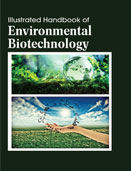Handbooks

Environmental biotechnology is a system of scientific and engineering knowledge related to the use of microorganisms and their products in the prevention of environmental pollution through biotreatment of solid, liquid, and gaseous wastes, bioremediation of polluted environments, and biomonitoring of environment and treatment processes. The advantages of biotechnological treatment of wastes are as follows: biodegradation or detoxication of a wide spectrum of hazardous substances by natural microorganisms; availability of a wide range of biotechnological methods for complete destruction of hazardous wastes; and diversity of the conditions suitable for biodegradation. This handbook provides comprehensive information on the diverse aspects of environmental biotechnology and also discusses the processes and new technologies dealing with pollutants, degradation and resource recovery.
Biotechnology is applied to and used to study the natural environment. Environmental biotechnology can make a significant contribution to sustainable development. It is one of today?s fastest growing and most practically useful scientific fields. Research into the genetics, biochemistry and physiology of exploitable microorganisms is rapidly being translated into commercially available technologies for reversing and preventing further deterioration of the earth?s environment. The aim of environmental biotechnology is to prevent, arrest and reverse environmental degradation through the appropriate use of biotechnology in combination with other technologies, while supporting safety procedures.
Illustrated Handbook of Environmental Biotechnology delivers wide-ranging information on the different aspects of environmental biotechnology and also discusses the processes and new technologies dealing with pollutants, degradation and resource recovery. Use of biotechnology to treat pollution problems is not a new idea. Communities have depended on complex populations of naturally occurring microbes for sewage treatment for over a century. Biotechnology applications in food security, agriculture, climate change, and climate mitigation are well known. The industrial applications of biotechnology are a profitable option for food and agriculture businesses. Moreover, these processes ensure that minimal damage is inflicted upon our environment. Usually, industries spend a huge amount on controlling the aftermaths of conventional industrial production processes but biotechnology ensures that money is saved at the time of production itself. Environmental Biotechnology utilizes the biochemical potential of microorganisms and plants for the preservation and restoration of the environment. It promotes sustainable and efficient use of natural resources like fungi, plants, algae, and bacteria in the industrial processes. Our biological systems have the capability to absorb and control pollutants like free carbon sources from our environment and keep our surroundings clean and green. Integrated with the industrial processes, it helps in forming a balanced industrial framework that has better efficiency, makes better use of natural resources, and also keeps our environment green. Green manufacturing technologies and sustainable development are the key issues that environmental biotechnology addresses. Illustrated Handbook of Environmental Biotechnology the environmental problems and solution of these problems by the help of microorganisms, improvement and development of new techniques for removal of the pollutant from the environment. This illustrated Handbook will be essential reading for students and researchers involving in the areas of Biotechnology or Environmental Science.